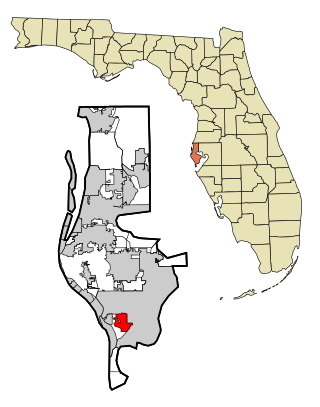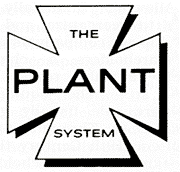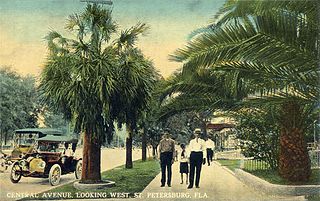Related Research Articles

Pinellas County is a county located on the west central coast of the U.S. state of Florida. As of the 2020 census, the population was 959,107, which makes it the seventh-most populous county in the state. It is also the most densely populated county in Florida, with 3,491 residents per square mile. The county is part of the Tampa–St. Petersburg–Clearwater Metropolitan Statistical Area. Clearwater is the county seat. St. Petersburg is the largest city in the county, as well as the largest city in Florida that is not a county seat.

St. Petersburg is a city in Pinellas County, Florida, United States. As of the 2020 census, the population was 258,308, making it the fifth-most populous city in Florida and the second-largest city in the Tampa Bay Area, after Tampa. It is the largest city in the state that is not a county seat. Along with Clearwater, these cities are part of the Tampa–St. Petersburg–Clearwater Metropolitan Statistical Area, the second-largest in Florida with a population of around 2.8 million. St. Petersburg is on the Pinellas peninsula between Tampa Bay and the Gulf of Mexico, and is connected to mainland Florida to the north.

Odessa is a census-designated place (CDP) in Pasco County, Florida, United States. The population was 3,173 at the 2000 census and more than doubled to 7,267 in 2010. Northwest of Tampa, Odessa had been an area of open spaces, ranching, and horse properties. More recently it has seen many suburban property developments as Tampa's population expands.

Clearwater is a city located in Pinellas County, Florida, United States, west of Tampa and north of St. Petersburg. To the west of Clearwater lies the Gulf of Mexico and to the southeast lies Tampa Bay. As of the 2020 census, the city had a population of 117,292. Clearwater is the county seat of Pinellas County and is the smallest of the three principal cities in the Tampa–St. Petersburg–Clearwater metropolitan area, most commonly referred to as the Tampa Bay Area.

Gulfport is a city in Pinellas County, Florida, United States, bordering St. Petersburg, South Pasadena, and Boca Ciega Bay. The population of Gulfport was 11,783 at the 2020 census. Gulfport is part of the Tampa–St. Petersburg–Clearwater metropolitan statistical area.

Oldsmar is a city in Pinellas County, Florida, United States. As of the 2020 census, the city had a population of 14,898. The Oldsmar name dates to April 12, 1916, when automobile pioneer Ransom E. Olds purchased 37,541 acres (151.92 km2) of land north of Tampa Bay to establish a planned community.

The Florida East Coast Railway is a Class II railroad operating in the U.S. state of Florida, currently owned by Grupo México.

The Seaboard Air Line Railroad, which styled itself as "The Route of Courteous Service", was an American railroad that existed from April 14, 1900, until July 1, 1967, when it merged with the Atlantic Coast Line Railroad, its longtime rival, to form the Seaboard Coast Line Railroad. Predecessor railroads dated from the 1830s and reorganized extensively to rebuild after the American Civil War. The company was headquartered in Norfolk, Virginia, until 1958, when its main offices were relocated to Richmond, Virginia. The Seaboard Air Line Railway Building in Norfolk's historic Freemason District still stands and has been converted into apartments.

Henry Bradley Plant, was a businessman, entrepreneur, and investor involved with many transportation interests and projects, mostly railroads, in the southeastern United States. He was founder of the Plant System of railroads and steamboats.

Hamilton Disston was an industrialist and real-estate developer who purchased 4 million acres (16,000 km²) of Florida land in 1881, an area larger than the state of Connecticut, and reportedly the most land ever purchased by a single person in world history. Disston was the son of Pennsylvania-based industrialist Henry Disston who formed Disston & Sons Saw Works, which Hamilton later ran and which was one of the largest saw manufacturing companies in the world.

The Plant System, named after its owner, Henry B. Plant, was a system of railroads and steamboats in the U.S. South, taken over by the Atlantic Coast Line Railroad in 1902. The original line of the system was the Savannah, Florida and Western Railway, running across southern Georgia. The Plant Investment Company was formed in 1882 to lease and buy other railroads and expand the system. Other major lines incorporated into the system include the Savannah and Charleston Railroad and the Brunswick and Western Railroad.

Peter Demens, born Pyotr Alexeyevitch Dementyev, was a Russian nobleman who migrated in 1881 to the United States and became a railway owner and one of the founders of St. Petersburg, Florida, United States.
The modern history of Tampa, Florida, can be traced to the founding of Fort Brooke at the mouth of the Hillsborough River in today's downtown in 1824, soon after the United States had taken possession of Florida from Spain. The outpost brought a small population of civilians to the area, and the town of Tampa was first incorporated in 1855.

Timeline of Pinellas County, Florida history.

The St. Petersburg Pier, officially known as the St. Pete Pier, is a landmark pleasure pier extending into Tampa Bay from downtown St. Petersburg, Florida, United States. Over the years several different structures have been built at the same location. The most recent structure, the third owned by the city, was a five-story inverted pyramid-shaped building, designed by St. Petersburg architect William B. Harvard, Sr. That Inverted Pyramid Pier was closed in 2013, and the new 26-acre Pier District opened on July 6, 2020. The $92 million dollar project includes five restaurants, a playground, an environmental education center, and numerous artworks including work by Xenobia Bailey, Nathan Mabry, Nick Ervinck, and a large sculpture entitled Bending Arc by Janet Echelman. Its opening was scheduled for May 30, 2020, but was postponed due to the COVID-19 pandemic in Florida.
Coffee Pot Park was a ballpark in St. Petersburg, Florida home to the St. Petersburg Saints minor-league baseball team until 1928, and spring training home of the St. Louis Browns and Philadelphia Phillies. Its capacity was approximately 850 for baseball. The park was named for the nearby Coffee Pot Bayou. The field was also used by local high school teams and for amateur softball. The ballpark was replaced in 1922 by Waterfront Park as the home to spring training in St. Pete.

This is a timeline of the U.S. state of Florida.
The Orange Belt Railway was a 3 ft narrow gauge railroad established in 1885 by Russian exile Peter Demens in Florida. It was one of the longest narrow gauge railroads in the United States at the time of its completion in 1888, with a mainline 152 miles (245 km) in length between Sanford and St. Petersburg. It carried citrus, vegetables, and passengers; and it interchanged with two standard gauge lines: the Jacksonville, Tampa and Key West Railway at Lake Monroe, and the Florida Central and Peninsular Railroad at Lacoochee.

This region of Pinellas was first settled in the 1830s and 1840s by Odet Phillippe, a French Huguenot from Charleston, SC, along with the McMullen Family from Quitman, Georgia and the British Richard Booth family who planted citrus groves and raised cattle. Following the Civil War, during the Reconstruction era, the city was founded by John C. Williams, formerly of Detroit, who purchased the land in 1876, and by Peter Demens, who was instrumental in bringing the terminus of the Orange Belt Railway there in 1888. St. Petersburg was incorporated on February 29, 1892, when it had a population of only some 300 people.
The following is a timeline of the history of the city of St. Petersburg in Pinellas County, Florida, United States.
References
- ↑ "Williams Park Bandstand Replica: A Brief Introduction" (PDF). dspace.nelson.usf.edu. Archived from the original (PDF) on December 27, 2015. Retrieved 2016-07-08.
- 1 2 "St. Petersburg: History - Railroad Line Leads to City's Founding, Early Baseball Days". www.city-data.com. Retrieved 2016-07-09.
- 1 2 Park, Mary (February 11, 2004). "Neighborhoodtimes: Tour gives rare peek in historic buildings". www.sptimes.com. St. Petersburg Times. Retrieved 2016-07-09.
- 1 2 3 "St. Petersburg Founded by Sufferer From Asthma". news.google.com. The Pittsburgh Press. February 10, 1935. Retrieved 2016-07-09.